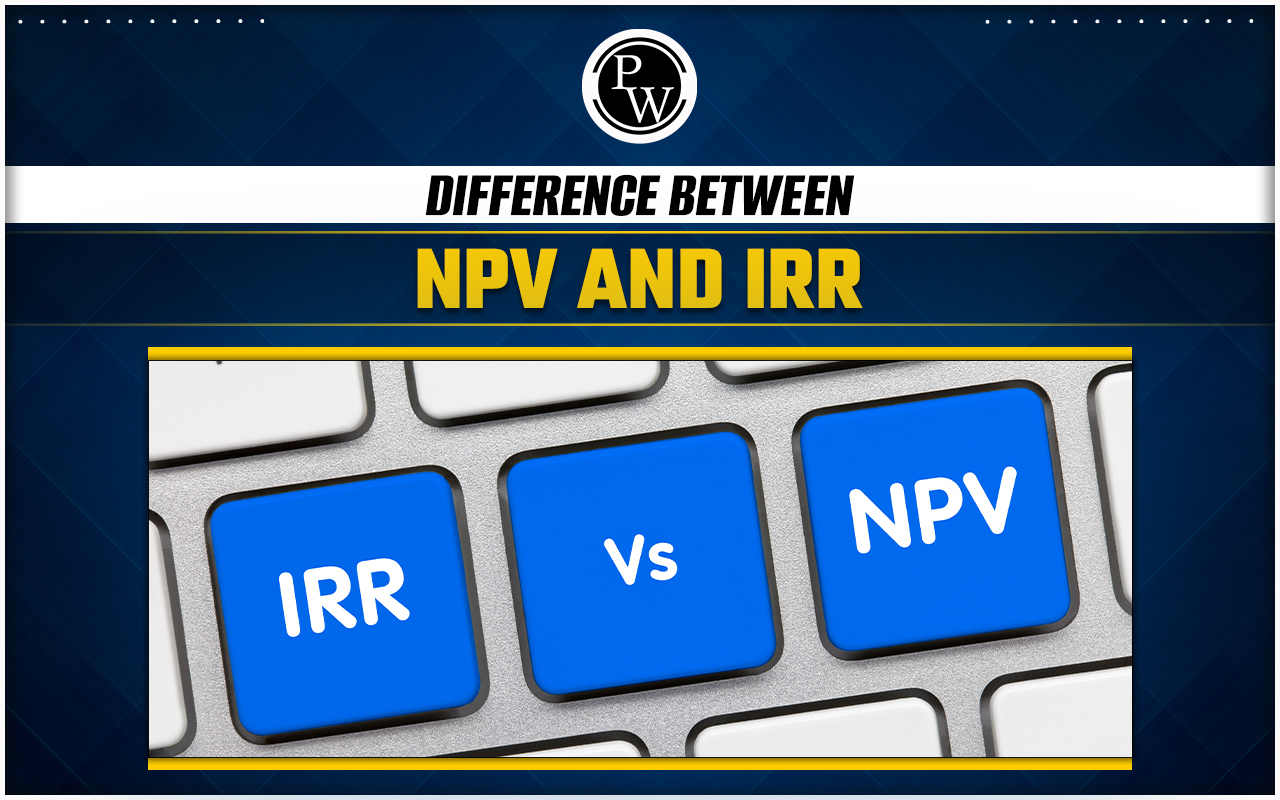

NPV and IRR: Net Present Value (NPV) and Internal Rate of Return (IRR) are both methods used to evaluate the potential of an investment, but they approach it differently. NPV measures the overall value an investment will generate by calculating the present value of all future cash flows and subtracting the initial investment cost. It provides a clear monetary figure showing the profit or loss.
In contrast, IRR determines the discount rate at which the investment's net present value becomes zero, essentially showing the break-even point. It gives the annual percentage return expected from the investment. While both metrics are useful in assessing investments, NPV focuses on the actual cash value, whereas IRR highlights the rate of return. Let's delve deeper into the differences between NPV and IRR for CA Exams .What is NPV?
Net Present Value (NPV) is a key financial metric used to assess the profitability and viability of an investment or project. It measures the difference between the current value of expected cash inflows and outflows. By discounting each cash flow to its present value, Net Present Value shows how much value an investment will add, compared to its costs, in today's money terms. If the Net Present Value is positive, it indicates that the expected earnings are greater than the projected costs, making the investment worthwhile. Conversely, a negative Net Present Value suggests that the costs outweigh the benefits, helping to guide smart financial decisions.What is IRR?
The Internal Rate of Return (IRR) is an important financial measure used to determine how profitable an investment or project might be. It is the discount rate that makes the Net Present Value of all cash flows from an investment equal to zero. In simpler terms, the IRR is the rate at which the value of future cash flows matches the initial investment, indicating when the project breaks even. A higher IRR suggests that an investment could be more profitable, making it a useful tool for comparing different investment options. By evaluating the IRR, investors and managers can better understand the potential profitability of investments, helping them make informed decisions.Also Check: Difference Between Accounting and Economic Profit
Difference Between NPV and IRR
Below is a comparison table that highlights the key differences between Net Present Value (NPV) and Internal Rate of Return (IRR), two essential metrics used in investment analysis.| Difference Between NPV and IRR | ||
|---|---|---|
| Aspect | Net Present Value (NPV) | Internal Rate of Return (IRR) |
| Definition | Calculates the net value an investment generates by subtracting the initial investment from the present value of future cash flows. | Finds the annual percentage return at which an investment breaks even (when NPV equals zero). |
| Measurement | Expressed in monetary terms (e.g., ₹, $). | Expressed in percentage terms (%). |
| Perspective | Shows the net value of the investment over its entire life. | Indicates the annual return rate over the investment’s life. |
| Dependency on Rate | Requires a discount rate for calculation. | Does not require a specified discount rate. |
| Decision Criterion | A positive NPV indicates a good investment. | An IRR higher than the required rate of return indicates a good investment. |
| Multiple Solutions | Always provides a single solution. | Can yield multiple solutions in specific scenarios. |
| Ease of Comparison | Less intuitive when comparing different investments. | More intuitive for comparing different investments. |
NVP or IRR Which Is Better?
Deciding between NPV and IRR depends on the unique aspects of the project. NPV offers a specific dollar amount that shows the project's value, making it clear and precise. On the other hand, IRR gives a percentage return, making it simpler to compare with other investments or a target rate of return. Typically, for complex or mutually exclusive projects, NPV is favored for its accuracy in representing value, while IRR is ideal for comparing straightforward projects. Using both methods together provides a well-rounded view of a project's financial potential. For a comprehensive understanding of NPV and IRR and other crucial CA topics, join PW CA Courses. Enhance your skills and boost your exam performance. Enroll now and excel in your CA journey!Difference Between NPV and IRR FAQs
What is the main difference between NPV and IRR?
NPV calculates the net value of an investment in monetary terms, while IRR determines the percentage return where NPV equals zero.
How is NPV calculated?
NPV is calculated by subtracting the initial investment from the present value of future cash flows, discounted at a specific rate.
What does a positive NPV indicate?
A positive NPV indicates that the investment’s expected earnings exceed its costs, suggesting it is worthwhile.
Why might IRR be preferred over NPV?
IRR is preferred for its simplicity in comparing the percentage return across different investments, making it easier to assess relative profitability.
Can NPV and IRR give conflicting results?
Yes, especially in projects with non-standard cash flows or multiple cash inflows and outflows. NPV is generally more reliable for complex decisions.
Talk to a counsellorHave doubts? Our support team will be happy to assist you!

Check out these Related Articles
Free Learning Resources
PW Books
Notes (Class 10-12)
PW Study Materials
Notes (Class 6-9)
Ncert Solutions
Govt Exams
Class 6th to 12th Online Courses
Govt Job Exams Courses
UPSC Coaching
Defence Exam Coaching
Gate Exam Coaching
Other Exams
Know about Physics Wallah
Physics Wallah is an Indian edtech platform that provides accessible & comprehensive learning experiences to students from Class 6th to postgraduate level. We also provide extensive NCERT solutions, sample paper, NEET, JEE Mains, BITSAT previous year papers & more such resources to students. Physics Wallah also caters to over 3.5 million registered students and over 78 lakh+ Youtube subscribers with 4.8 rating on its app.
We Stand Out because
We provide students with intensive courses with India’s qualified & experienced faculties & mentors. PW strives to make the learning experience comprehensive and accessible for students of all sections of society. We believe in empowering every single student who couldn't dream of a good career in engineering and medical field earlier.
Our Key Focus Areas
Physics Wallah's main focus is to make the learning experience as economical as possible for all students. With our affordable courses like Lakshya, Udaan and Arjuna and many others, we have been able to provide a platform for lakhs of aspirants. From providing Chemistry, Maths, Physics formula to giving e-books of eminent authors like RD Sharma, RS Aggarwal and Lakhmir Singh, PW focuses on every single student's need for preparation.
What Makes Us Different
Physics Wallah strives to develop a comprehensive pedagogical structure for students, where they get a state-of-the-art learning experience with study material and resources. Apart from catering students preparing for JEE Mains and NEET, PW also provides study material for each state board like Uttar Pradesh, Bihar, and others
Copyright © 2025 Physicswallah Limited All rights reserved.
Get App











